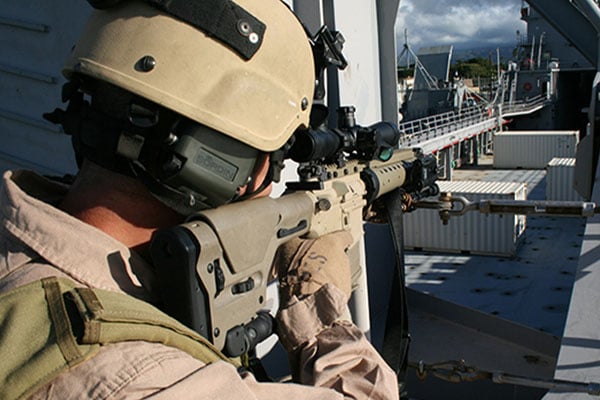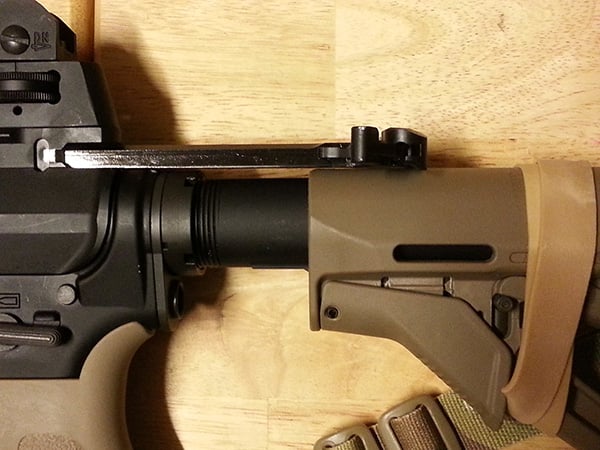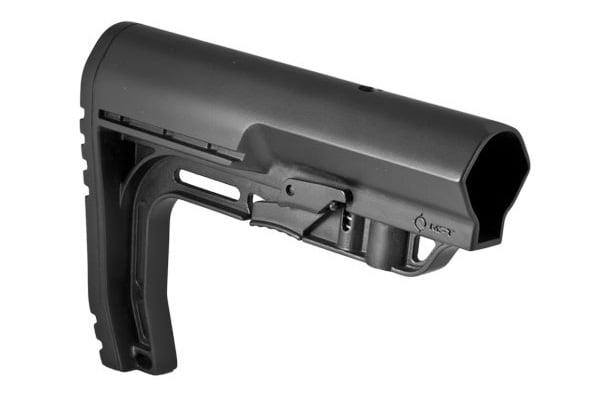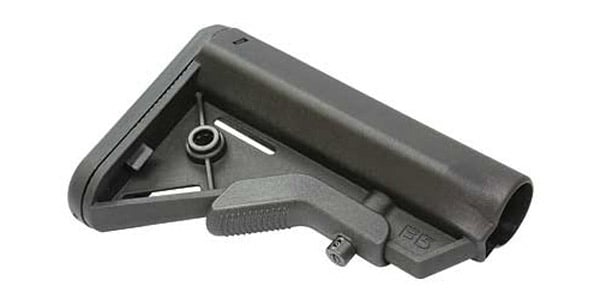
Last Updated on
By David Curtis
I believe at this point it’s safe to say that the AR-15 is the most modular firearm of all time. It was probably already true at the beginning of the global war on terror, but its popularity and the dazzling variety of accessory options has absolutely exploded since the Assault Weapon Ban was allowed to sunset. To some extent, though, this popularity is a two edged sword. For example, you can get an AR-15 stock in almost any configuration you could want. But what if you’re the average shooter or a new builder who just wants to make a solid well-informed choice without having to explore the specs of 120 different options? Well, you’ll need a guide like this one.
The first and most obvious purpose of a rifle’s stock is to steady it during recoil with the mass of the shooter. As a related function, it also helps support the gun during aiming by connecting it to the shooter’s bone structure and thereby his stance. To these ends it is nice if a stock is not uncomfortable like the hard corners of the Mosin-Nagant’s steel butt plate. Fortunately, I have yet to run across any AR stocks quite that bad. It can also help in this purpose if the stock has a pad, texture, or shape that helps it grip the shoulder.
The second purpose of the stock is to fit the rifle’s length of pull to the shooter and their stance. Length of pull is defined as the distance from the center of the butt to the center of the trigger. Different shooters require different lengths to be able to operate the rifle comfortably and efficiently, and different stances benefit from minute length adjustments. This is one area where the AR-15 has excelled over most popular rifles that came before it. The collapsible stock design is nearly as old as the M16 itself and today offers a wide range of length adjustment options. For example, my daughter would be physically incapable of acquiring a proper shooting stance with the full-length stock of the M16A2 at her age. But she could do quite well with the M4 style collapsible stock on a S&W M&P15-22.
The third purpose of a rifle’s stock is to place the shooter’s eye in line with sights. This is one area where the AR-15 does not excel, and I’ll explain why a little later. Most AR stocks do not take this feature into account and there is simply a single standard sight height for all applications and users. Fortunately this works well enough for most users that it is not a huge detriment. If you have a different requirement due to the size of a scope, the shape of your face, etc, then your stock options may be pretty limited.
In addition to the above bases that a rifle stock has to cover, an AR-15 stock typically has a few extra features mixed in. This is where most of your subjective or preferential decision making will come into play. You get to wade through options like sling attachment types and quantity, storage compartments, accessory mounts, and various cheek rest shapes. These secondary features are less about questions of “which AR stock to choose” and more about questions like “which type of sling swivels and attachments to use.” Want to use QD swivels? Pick one of the many stocks that come with or can accept QD swivel sockets.
With so many options, the stock selection for the AR-15 really can be the rifle builder’s dream come true. But the AR isn’t perfect. It has two specific design features that place limitations on what the AR stock can do.
The most obvious feature affecting stock design is the receiver extension; commonly known as the buffer tube. The AR-15’s relatively long bolt carrier group is housed entirely in the upper receiver when the bolt is in battery, but the rest of the moving parts of the action are housed in the receiver extension. Additionally, during the cycle, the bolt carrier itself retracts about half way into the extension. All this means that in order for your AR to work, there has to be a buffer tube there. Since the stock is mounted to that tube, the stock has to stay put in line behind the bore of the barrel. Some other rifles have designs that allow their stocks to fold for compact storage, but barring some serious modifications, the AR’s stock has to stay put.

The other big feature affecting stock design is the location and function of the charging handle. The charging handle needs to be able to retract three and a half inches to the rear, and it needs to do that about an eighth of an inch above the receiver extension. This puts some pretty strict limits on what you can do in the way of a cheek riser, and is the reason I mentioned above that the AR-15 stock cannot be quite as adjustable as most target rifle stocks. Any cheek riser must begin about three and a half inches back from the rear of the receiver, limiting how far forward the head can be placed on the stock. Also this unfortunately puts limitations on what types of materials should be used to build the stock. There are wooden stocks available, but they tend to crack in the area above the receiver extension because the wood must be too thin through that area to maintain strength.
There are a few options out there to work around these features, or to change the layout of the major parts of the rifle. There are “side charging” upper and bolt carrier sets that mount the charging handle to the side of the carrier itself. There have been rifles where the recoil system was mounted forward of the receiver, over the barrel. But, those are pretty unique configurations, so we won’t spend any more time on them.
Of the stock options you’ll encounter for a typical AR-15 build or upgrade project, there are two main types: “rifle” and “carbine”. The distinctions in this case are really based on which type of parts are used in your buffer assembly. The stock you choose will determine what type of buffer system you need (or vice versa if you’re not interested in disassembling the buffer assembly already included on a factory rifle).

The first type are stocks which mount to the “rifle” receiver extension. This type of extension uses a rifle length buffer and rifle length buffer spring. The stock is mounted to the rear end of the extension by a screw, and kept from rotating by keying into a recess on the rear of the lower receiver. This was the original configuration of the M16 and has continued in use through the A2 and A4 models still in service. The original stock is now called the A1. The M16A2 introduced the A2 stock which is about three quarters of an inch longer. Both feature a trap-door in the buttplate and a fixed sling loop at the toe. More recent options of this type include the Ace Skeleton stock, Magpul PRS, Magpul MOE Rifle Stock, and the Luth-AR stocks.

The other main type are the stocks which attach to the “carbine” receiver extension. In this type, the buffer assembly components are shorter than in a rifle assembly. The stock body in this type slides onto the receiver extension and attaches to a rail forged into the bottom of the tube. The rail has between two and six detents along its length. The stock has a spring loaded pin that locks into the detents. The length of the stock is changed by pressing the release lever which retracts the pin, sliding the stock to the desired length, and releasing the lever so the pin can lock into the nearest detent. As a side note here, there is no such thing as a six-position stock. But there are six (or five, or two) position buffer tubes. Also, there are a couple of collapsible stocks that come with their own specific receiver extensions: the Ergo F93 Pro and the Magpul UBR.
Collapsible stocks were in development almost immediately after the M16 was first adopted in 1962, with the earliest version of the current arrangement made available in 1966 on the Colt Commando. The carbine configuration is now best known on the M4 Carbine, which has replaced most of the M16s in use by the U.S. Army. Carbine stocks are very popular, and there are probably too many available now to list them all.
A word of caution for the builder here: individual components from the different types of buffer assemblies should never be interchanged. Doing so will cause an issue somewhere between short stroking and permanently locking the bolt to the rear and preventing disassembly with the potential of damaging or breaking off the rear of your lower receiver. It’s all one type or the other.
As I’ve said, the purpose of the rifle determines the requirements for the stock. So lets look at some of the common types of rifle builds and then I’ll mention a few stocks particularly suited to those purposes along with a few of my thoughts about their features.

The most common purpose-specific AR stocks are probably those for precision-oriented builds. The main thing I would expect of a precision stock would be sturdiness. Any movement between a carbine stock and tube would introduce the potential for inconsistency, which never helps accuracy. Bonus features you might want could include length and cheek adjustability to tune the stock for the shooting position. Some extra weight would also help the rifle to be more stable during aiming and recoil which in turn may help you to be able to watch your hits through the scope. Of these stocks, the Magpul PRS has pretty much dominated the market since its release. It’s particularly heavy and was probably the first commercial AR stock to offer a cheek riser and length that are click-adjustable. It also has a hidden picatinny rail at it’s toe for mounting a rear monopod.
A relative newcomer to this market is the LuthAR MB-1. The MB-1 offers length and cheek height adjustments as well, though they are not click adjustable but of the set it and forget it type. It leaves off the other features of the PRS and is half the weight and half the price. My only subjective gripe about the MB-1 is that the cheek riser is wider than that of the PRS. I’m not a fan of the wide sloped cheek rests on some AR stocks, though obviously many other people like them.
In reality, any fixed stock or collapsible stock that is sufficiently tight on it’s tube might be fine for your needs here. Service rifle shooters add lead weights to their A2 stocks when they want to increase stability. The MK-12 SPRs, a sort of light sniper rifle used by special operations forces, were commonly seen with SOPMOD stocks from LMT or B5 Systems. As long as the stock fits you to the gun and the sights and doesn’t otherwise get in your way, you can use it on a precision build.

Another kind of AR project gaining popularity is the lightweight build. Here the goal is simply to build a gun as light as practical, or as light as possible for you ultra-lighters. The lightest stocks I know of are the Battle Arms Development LBS and the ACE UltraLight. These run 3 and 5 ounces respectively, but they’re both fixed stocks. If you need adjustability, the Minimalist by Mission First Tactical or the TactLite by ATI probaby have what you need. Both weigh less than 6 oz and include a QD swivel socket as a bonus. Other notable carbine stocks that are pretty light are the original CAR and M4 stocks from Colt and their clones.
With those first two done, lets look at the general-purpose AR. This type of build has adaptability as one of its primary goals. One way to look at building a general purpose AR would be to use as much weight as you need for the barrel and optic, and then try to shave as much weight as possible from other areas such as the handguard and stock. In that sense it’s a sort of a hybrid between the precision gun and a lightweight. For our purposes, that gives us the same stock options as the lightweight list. For a less extreme build, perhaps with a medium weight barrel, medium weight stocks become a strong option. The latest and greatest in this light medium range is probably the BCM Gunfighter Stock. They redesigned the latch mechanism to make it the most durable carbine stock on the market. It also includes rotation limited QD sockets and a neat tab to keep sling retention bands where you put them. Other options in this light medium range would be the B5 Bravo and Magpul MOE SL.

Another way to look at weight in stocks is consider how it affects the center of balance of the gun. A stock that weighs most of a pound may add enough weight to the rear of the gun to keep it from feeling barrel-heavy or to make it feel faster in target transitions. The Magpul ACS and ACS-L and the VLTOR EMod have always been popular for this use, as well as the Magpul UBR. Some 3 Gun competition shooters even use the Magpul PRS for this reason.
Hunting is another purpose for ARs worth mentioning, but I think in this case the different types of hunting cause the specific usage to fall under one of the other categories I’ve already mentioned. You may need a heavy precision hunting rig, an ultralight carbine to pack way into the backcountry, or a general purpose build that attempts to combine the practical features of the two.
So what stocks do I use? My AR started out with a Magpul CTR. I liked that it was fairly light at the time, and included a QD socket. Eventually something about it began to bother me, though. I kept its friction lock lever open as a sling band tab, so it had just enough wobble that it would pluck my beard when I shouldered the gun. So I swapped it for the Magpul Fixed Carbine Stock. It’s the same length as the CTR was where I typically set it, and I added Magpul’s sling mount kit so that it’s functionally the same to me.
The good news in all of this is that most AR stocks are of good quality and will work as expected in the primary functions required of them. As long as the overall feature set supports what you want to do with your rifle, which particular one you choose shouldn’t matter too much. It certainly won’t make or break your build. And if your goals for the rifle change over time (perhaps I should say “when they change”), then it’s normally not too hard to change out stocks as needed.




Leave a Reply